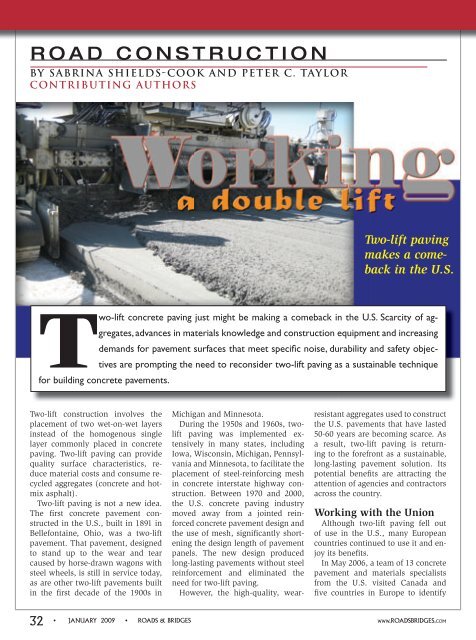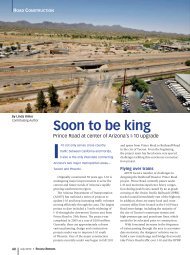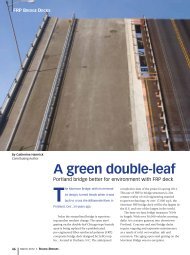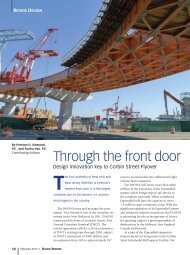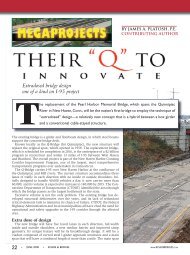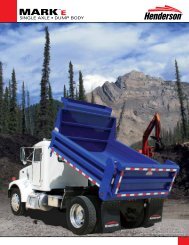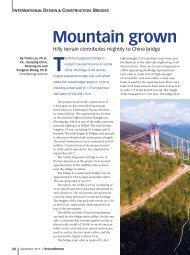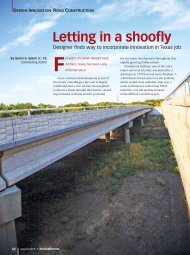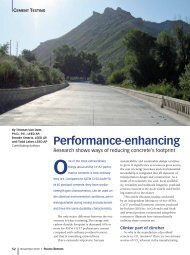Two-lift paving makes a come - Roads & Bridges
Two-lift paving makes a come - Roads & Bridges
Two-lift paving makes a come - Roads & Bridges
Create successful ePaper yourself
Turn your PDF publications into a flip-book with our unique Google optimized e-Paper software.
ROAD CONSTRUCTIONBY SABRINA SHIELDS-COOK AND PETER C. TAYLORCONTRIBUTING AUTHORS<strong>Two</strong>-<strong>lift</strong> <strong>paving</strong><strong>makes</strong> a <strong>come</strong>backin the U.S.<strong>Two</strong>-<strong>lift</strong> concrete <strong>paving</strong> just might be making a <strong>come</strong>back in the U.S. Scarcity of aggregates,advances in materials knowl edge and construction equipment and increasingdemands for pavement surfaces that meet specifi c noise, durability and safety objectivesare prompting the need to reconsider two-<strong>lift</strong> <strong>paving</strong> as a sustainable techniquefor building concrete pavements.<strong>Two</strong>-<strong>lift</strong> construction involves theplacement of two wet-on-wet layersinstead of the homogenous singlelayer commonly placed in concrete<strong>paving</strong>. <strong>Two</strong>-<strong>lift</strong> <strong>paving</strong> can providequality surface characteristics, reducematerial costs and consume recycledaggregates (concrete and hotmixas phalt).<strong>Two</strong>-<strong>lift</strong> <strong>paving</strong> is not a new idea.The first concrete pavement constructedin the U.S., built in 1891 inBellefontaine, Ohio, was a two-<strong>lift</strong>pavement. That pavement, designedto stand up to the wear and tearcaused by horse-drawn wagons withsteel wheels, is still in service today,as are other two-<strong>lift</strong> pavements builtin the first decade of the 1900s inMichigan and Minnesota.During the 1950s and 1960s, two<strong>lift</strong><strong>paving</strong> was implemented extensivelyin many states, includingIowa, Wis consin, Michigan, Pennsylvaniaand Minnesota, to facilitate theplace ment of steel-reinforcing meshin concrete interstate highway construction.Between 1970 and 2000,the U.S. concrete <strong>paving</strong> industrymoved away from a jointed reinforcedconcrete pavement design andthe use of mesh, signifi cantly shorteningthe design length of pavementpanels. The new design producedlong-lasting pavements without steelreinforcement and eliminated theneed for two-<strong>lift</strong> <strong>paving</strong>.However, the high-quality, wearresistantaggregates used to constructthe U.S. pavements that have lasted50-60 years are becoming scarce. Asa result, two-<strong>lift</strong> <strong>paving</strong> is returningto the forefront as a sustainable,long-lasting pavement solution. Itspotential benefits are attracting theattention of agencies and contractorsacross the country.Working with the UnionAlthough two-<strong>lift</strong> <strong>paving</strong> fell outof use in the U.S., many Europeancountries continued to use it and enjoyits benefits.In May 2006, a team of 13 concretepavement and materials specialistsfrom the U.S. visited Canada andfive countries in Europe to identify32• JANUARY 2009 • ROADS & BRIDGES WWW.ROADSBRIDGES.COM
strategies and specifications used todesign long-life concrete pavements.The team included members fromthe Federal Highway Administration(FHWA), state DOTs and the NationalConcrete Pavement TechnologyCenter (National CP Tech Center),as well as contractors and materialssuppliers.After the scan tour, the team analyzedthe techniques they had seental pavement thickness. The bottom<strong>lift</strong> generally contains locally availableor recycled aggregates that maynot be suitable as a wearing surface.These aggregates can be obtained ata lower cost than aggregates used ina traditional <strong>paving</strong> project.The top layer, on the other hand,is relatively thin and contains dense,wear-resistant aggregates that provideenhanced durability, reducedA Kansas DO<strong>Two</strong>rker lookson as the beltspreader placesthe top-<strong>lift</strong>concrete. (Photocourtesy of PeterTaylor).in Europe and selectedtwo-<strong>lift</strong> <strong>paving</strong> asthe strategy with thegreatest potential forproducing a cost-effective,sustainable,long-lasting pavementin the U.S.Laying it onthick—and thinSustainable solutions are thosethat balance economic, environmentaland social benefits.“Sustainability is not about perfection,”said Tom Van Dam, programdirector for materials and sustainabilityat Applied Pavement Technology.“It’s about balancing competing, andoften contradictory, interests.”The two-<strong>lift</strong> process has great potentialas a sustainable <strong>paving</strong> solution,said Van Dam. It reduces thecost of materials and materials transportation,reduces the environmentalimpact caused by quarrying andimporting aggregates and increasessocietal benefits by lowering noiselevels and providing a long-lastingpavement that does not need frequentreconstruction.In two-<strong>lift</strong> <strong>paving</strong>, the bottom layeris thick, typically 80-90% of the to-noise and increased friction. Whilethese aggregates are more costly andfrequently have to be imported, theoverall cost and environmental impactof the pavement system is reducedbecause only a small amountof aggregates is required.“<strong>Two</strong>-<strong>lift</strong> is optimized for recyclingand reuse,” said Joep Meijer, presidentof the Right Environment, anenvironmental consulting firm inAustin, Texas. “Recycling is basicallyembedded in the technology.”Since the bottom <strong>lift</strong> is not subjectedto as harsh an environmentas the top <strong>lift</strong>, a variety of recycledaggregates, including concrete or asphaltpavements, can be used in thebottom <strong>lift</strong> without sacrificing durability.“We can use the road that is alreadythere—just crush it up and useit in the new road,” explained Meijer.<strong>Two</strong>-<strong>lift</strong> <strong>paving</strong> also can be optimizedto reduce the environmentalimpact caused by cement production.“The concrete industry is wellaware of the energy intensity andCO 2emissions related to cement production,so we’re looking into optionsto reduce clinker content fromcement,” said Meijer.One way to reduce the cement contentof concrete is to use supplementarycementitious materials, such asfly ash. This strategy is commonlyused in concrete <strong>paving</strong> projects andcan be used in higher quantities intwo-<strong>lift</strong> <strong>paving</strong>.Quiet, safe, long-lasting pavementsmean happy citizens. <strong>Two</strong>-<strong>lift</strong> pavementshave the potential to meetall of these criteria through surfacetreatments such as exposed aggregatesurfaces.Creating an exposed aggregate surfacerequires using extra-hard, wearresistant,small aggregates. Whensmall aggregates are used, more cementpaste must be used, which increasesboth the cost of the concretemix and the energy and CO 2footprintof the pavement. However, thethin top <strong>lift</strong> of a two-<strong>lift</strong> pavementneeds only a relatively small amountof concrete, making exposed aggregatesurfaces a possibility withoutincreasing the cost or the environmentalimpact.ROADS & BRIDGES • JANUARY 2009 •33
aThe exposed aggregate surface was produced by using small,wear-resistant rhyolite aggregates. (Photo courtesy of KDOT)Results from Europe, where exposedaggregate surfaces are commonlyused, suggest that these surfacesreduce tire-pavement noise,leading to quieter pavements. Theteam also hopes that exposed aggregatesurfaces will increase skid resistance,potentially making the pavementsafer.American-made caseOnce the European scan teamidentified two-<strong>lift</strong> <strong>paving</strong> as its firstpriority, the next step was to set updemonstration projects in variouslocations throughout the U.S. Workingwith the FHWA, the NationalCP Tech Center coordinated the firstdemonstration project in Kansas.“In Kansas, they were strugglingbecause the local limestone in Kansasis not wear-resistant,” explained VanDam. Kansas would like to importaggregates that are denser and morewear-resistant from other states, butthese imported aggregates <strong>come</strong> at ahigher cost.While reducing costs is a plus, itwas not the primary reason Kansasvolunteered to do a demonstrationproject, said Rod Montney, a concreteresearch engineer with the KansasDOT.“Our goal was really just to provethat two-<strong>lift</strong> <strong>paving</strong> could be done inthe U.S. with American equipment,”he said.For the I-70 two-<strong>lift</strong> project, Kan-sas imported dense, wear-resistantrhyolite aggregates from Oklahomafor the top <strong>lift</strong> but used locally available,more porous limestone aggregatesfor the bottom <strong>lift</strong>, significantlylowering the cost of purchasing andtransporting materials.The team used a standard KansasDOT <strong>paving</strong> mix for the 300-mm bottom<strong>lift</strong>. They also used a combinationof admixtures to stiffen the bottom<strong>lift</strong> and prevent segregation.The rhyolite was used as a coarseaggregate in the 40-mm top <strong>lift</strong>. Toreduce permeability, the contractorsubstituted a Class F fly ash-gypsumcombination for 20% of the cementin the top <strong>lift</strong>.The Kansas DOT contracted withKoss Construction for the I-70 two<strong>lift</strong>project.“Koss got on board right from thebeginning,” said Montney. “Theyhad been thinking about two-<strong>lift</strong><strong>paving</strong> and said, ‘Let’s try it on theI-70 project.’”Koss used a dual-drum mixingplant to simultaneously produce thetwo concrete mixes. Green and redplacards were used to identify whichmix each truck was carrying: a greenplacard told the road crew the truckwas delivering to the bottom <strong>lift</strong>spreader (which was marked withgreen paint); a red placard indicatedthe concrete was for the top <strong>lift</strong>spreader (which was marked withred paint).The pavement was placed on a150-mm, cement-treated recycledconcrete base produced from thepre-existing concrete pavement.During the <strong>paving</strong> process, thebottom-<strong>lift</strong> concrete was placed inthe belt spreader to deliver concreteto the base. The first paver followedbehind the belt spreader to form thefinal pavement profile for the bottom<strong>lift</strong>. Almost immediately after thebottom <strong>lift</strong> was placed, it was stiffenough to support the weight of theworkers.The top <strong>lift</strong> was then deliveredto a second belt spreader, with thesecond paver forming the final pavementprofile. The total distance ofthe <strong>paving</strong> operation from the firstbelt spreader to the final paver wasless than 45 meters. In this wet-onwetapplication, both the bottom andtop <strong>lift</strong>s were completed in about 30-60 minutes.The Kansas DOT experimentedwith several different pavement surfacetextures as part of the I-70 two<strong>lift</strong>project, including longitudinaltining, grooving, Astroturf drag andan exposed aggregate surface.The exposed aggregate surfacecontained a much smaller aggregate—9.5-mmrhyolite—comparedwith the other surface test sections,which used 12.5-mm rhyolite in thetop <strong>lift</strong>. Fine mason sand was usedin the exposed aggregate section,whereas standard river sand wasused in other top-<strong>lift</strong> surface test sections.To create the exposed aggregatesurface, retarder was sprayed on thesurface of the top <strong>lift</strong> to prevent theconcrete from setting. White sheetingwas used to cure the retardedsurface.After a five-hour curing time, thewhite sheeting was removed and thesurface exposed for 15-20 minutesbefore brooming to remove the retardedpaste from the surface and exposethe aggregate. After brooming,white curing compound was appliedto provide final cure for the exposedaggregate surface. Transverse and34• JANUARY 2009 • ROADS & BRIDGES WWW.ROADSBRIDGES.COM
alongitudinal joints were later sawedinto the surface.On-board sound intensity (OBSI)tests were conducted on each of thedifferent surface textures. All surfacesshowed lower tire-pavement noisethan a traditional concrete pavement.Opening mindsNearly 100 people—contractors,material suppliers and agency representatives—from15 states attendedthe National <strong>Two</strong>-Lift Paving OpenHouse in Salina, Kan., on Oct. 15-16,2008.Participants heard presentationsfrom European and U.S. experts,including those involved with theKansas project. They also visitedthe project site and examined theexposed aggregate and other experimentalsurfaces.Additional open houses will beheld as other demonstration projectsare completed over the next twoyears.The National CP Tech Center issetting up demonstration projects inother states in 2009. The goal is tohave two more open houses in thenext year or two, said director TomCackler.Cackler sees two-<strong>lift</strong> <strong>paving</strong> as atool that can help “optimize concretepavements to meet local needs—such as specific surface characteristics,scarcity of local materials orrecycling of existing pavements—sothat a long-life pavement can be builtwith an economic and sustainableapproach.”Van Dam said he expects to see alot more versatility with two-<strong>lift</strong> <strong>paving</strong>in the future.“Once we’ve proved the concept,people will start to think about optimizingthe top layer to resist moistureloss, resist cracking . . . There are alot of potential benefits we haven’teven begun to realize,” he said.The ill effects of moisture loss canbe reduced through the use of internalcuring or shrinkage-reducing admixtures,explained Van Dam, andfiber reinforcement can be used tohelp reduce cracking.“When it <strong>come</strong>s to two-<strong>lift</strong> <strong>paving</strong>,”he said, “we’re just scratchingthe surface.”For more information about two<strong>lift</strong><strong>paving</strong> and the Kansas demonstrationproject, visit the NationalCP Tech Center’s website at www.cptechcenter.org/projects/two-<strong>lift</strong><strong>paving</strong>/index.cfm.Shields-Cook is a communications specialist withthe National Concrete Pavement Technology Center,Ames, Iowa. Taylor is an associate director with theNational Concrete Pavement Technology Center.LearnMore!For more information related to this article, goto: www.roadsbridges.com/lm.cfm/rb010919“Word on the Street is Neenah”Road Roller Matsare made with fibers from the almost indestructibleouter husk of the coconut bonded into a vinyl backingand attached on scraper plates to clean frontand rear rollers. They install easier than wovenmats and can be cut to fit without unraveling.For FREE Samples & More InformationBRIDGE SCUPPERS | DETECTABLE WARNING PLATES | COMBINATION INLETSAIRPORT CASTINGS | MANHOLE FRAMES & COVERS | TRENCH CASTINGSVALVES & GATES | INLET FRAMES & GRATES | ACCESS & HATCH COVERSDRAINAGE GRATES | ROLL & GUTTER INLETS800-558-5075 | www.neenahfoundry.comP.O. Box 7038 • Akron, OH 44306 • Fax (330) 773-3254800-321-2381 • E-mail info@mussonrubber.com • www.mussonrubber.comCircle 773NEENAH FOUNDRY CO.IS A SUBSIDIARY OFThese products are to be specified and used under the guidance of qualified design professionals.Circle 774ROADS & BRIDGES • JANUARY 2009 •35


